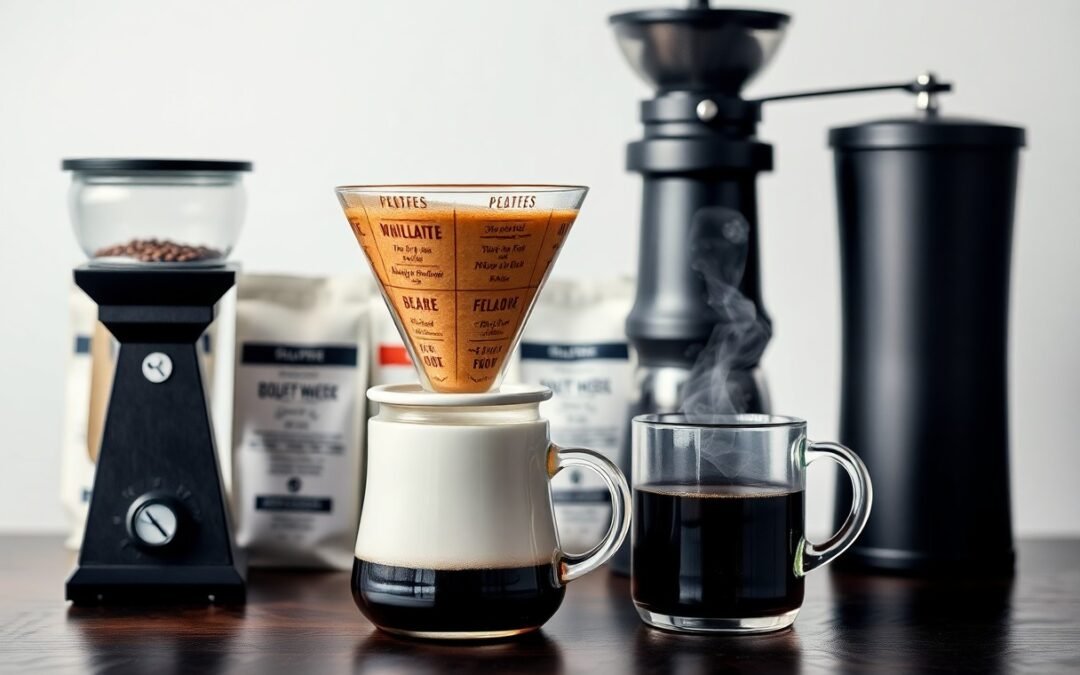With the increasing variety of artisan coffee available, you have the opportunity to enhance your sensory experience and appreciation for this beloved beverage. Understanding how to taste and articulate the distinct flavor profiles of different coffees can elevate your enjoyment and knowledge. This guide will provide you with the techniques and vocabulary needed to identify and describe the unique characteristics of artisan coffee, enabling you to engage more fully with each cup you savor.

The Language of Flavor: A Comprehensive Glossary
Mastering the terminology associated with artisan coffee allows you to articulate your tasting experiences with greater precision. A well-defined glossary not only enhances your appreciation for flavor profiles but also aids in communicating your insights. Familiarity with key terms such as acidity, body, sweetness, and finish will elevate your tasting sessions and deepen your understanding of what makes each cup unique.
Key Tasting Terminology
Understanding crucial tasting terminology is foundational to your coffee journey. Terms like “brightness” indicate acidity levels, while “full-bodied” refers to the coffee’s weight on the palate. “Sweetness” describes the pleasant sugar-like taste, and “finish” captures the lingering flavor after sipping. By utilizing precise language, you enrich the conversation around artisan coffee, making it easier to share your experiences with others.
Understanding Flavor Complexity
Flavor complexity in coffee can transform a simple sip into a multi-dimensional experience. It involves the interplay of various flavors, aromas, and sensations that evolve throughout the tasting process. You may notice initial notes of chocolate giving way to brighter citrus or even spicy undertones. This complexity is influenced by factors such as the coffee’s origin, processing method, and roast profile. The more you explore and identify these layers, the deeper your appreciation for coffee becomes.
In artisan coffee, flavor complexity is often assessed through cupping sessions that reveal diverse notes unique to each origin. For example, Ethiopian coffees might present intricate floral aromas intertwined with berry-like sweetness, while Guatemalan varieties could offer rich chocolate and nutty qualities. Understanding these nuanced, evolving flavors allows you to savor every cup fully, appreciating how different elements harmonize or contrast within a single brew. This depth makes the drinking experience not only enjoyable but also intellectually stimulating.
The Sensory Journey: Engaging All Five Senses
Each cup of artisan coffee offers a rich sensory experience, allowing you to engage not just your palate, but all five senses. Starting from the moment the coffee is brewed, the aromas, visuals, sounds, and even the tactile sensations contribute to your overall appreciation. To truly master coffee tasting, you must learn to recognize and articulate these sensory impressions, transforming a simple cup into a complex exploration of flavors.
Aroma: The First Impression
Aroma is your gateway to the coffee’s flavor profile, often revealing subtle notes before you even take a sip. As soon as you open a bag of coffee, notice the diverse scents—floral, fruity, or nutty—that evoke expectations for the tasting experience ahead. Swirling the coffee in your cup releases further aromatic complexities, enhancing your understanding of its intricacies.
Texture and Body: The Mouthfeel Experience
The body of coffee refers to its weight and texture on your palate, which significantly influences your tasting experience. A full-bodied coffee may feel creamy or syrupy, often leaving a robust impression that lingers. In contrast, a light-bodied coffee typically offers a more delicate, tea-like sensation that refreshes the mouth. Understanding these elements allows you to better express the physical aspects of your coffee experience.
A coffee’s texture and body can evoke various sensations that enhance your perception of its flavor. For instance, an espresso might present a thick, velvety mouthfeel due to its brewing method, while a pour-over may yield a cleaner, lighter body. Observing how these elements interact with the flavor profiles, such as acidity and sweetness, deepens your appreciation and expression of artisan coffee nuances.
Aftertaste: The Lasting Impression
The aftertaste, or finish, is what lingers on your palate after swallowing. This impression can reveal more about the coffee’s complexity, with flavors that evolve and change over time. A coffee with a long, pleasantly lingering aftertaste leaves a memorable mark, while a clean finish might indicate a more balanced cup. Recognizing the aftertaste is crucial for a holistic tasting experience.
Your perception of the aftertaste can greatly influence your overall enjoyment of the coffee. A lingering bitterness or sweetness can be telling of the roasting process or the coffee’s varietal. For instance, a fruity Ethiopian coffee may leave a bright, berry-like aftertaste, while a dark roast could impart a smokier, more assertive finish. Evaluating this component helps you to appreciate the layered complexities inherent in artisan coffee.
Unlocking Coffee’s Flavor Identity: Factors at Play
Your coffee’s flavor identity emerges from a complex interplay of several factors. These include the geographic origin of the beans, the processing methods employed, and the roast profile. Understanding how each of these elements contributes to the final taste is important for any coffee enthusiast. The nuances can transform an average cup into an extraordinary experience.
- Bean origin and terroir
- Processing methods and their influence
- Roasting specifics: degree and duration
Knowing the intricacies of these factors allows you to appreciate and describe your coffee with greater depth.
The Role of Bean Origin: Terroir and Its Impact
Your coffee’s origin offers insights into its flavor potential. Beans sourced from regions like Ethiopia may exhibit fruity and floral notes, while those from Brazil often lean toward chocolate and nuttiness. Terroir, or the environmental conditions of the growing area, influences acidity, body, and flavor nuances significantly.
Processing Methods: How They Shape Flavor
Processing methods significantly affect the flavors in your cup. The choice between washed, natural, or honey processing alters the final taste profile of the coffee. For instance, natural processed beans generally present more vibrant fruit characteristics, while washed beans display cleaner, more acidic flavors.
Understanding the nuances in processing methods can enhance your appreciation of coffee. For example, the natural processing technique allows the coffee cherries to dry with the fruit intact, leading to a more pronounced sweetness and complexity. Conversely, washed processing results in a brighter and more acidic cup, emphasizing the bean’s intrinsic qualities. Knowing these differences enhances your ability to choose or describe your coffee preferences accurately.
Roast Profiles: Balancing Acidity and Sweetness
Roast profiles play a pivotal role in determining your coffee’s final flavor. Lighter roasts often showcase a brighter acidity and pronounced fruity notes, while darker roasts bring out sweetness and deeper caramel flavors. A successful roast balances these elements, creating a harmonious tasting experience.
Delving into roast profiles reveals how varying the time and temperature impacts flavor development. For instance, a light roast will maintain higher acidity and floral notes, perfect for highlighting origin characteristics. In contrast, medium to dark roasts generally produce a fuller body and richer sweetness, folding in notes of chocolate and nuttiness. This balance affects your overall tasting experience and allows you to explore a range of flavor profiles and preferences, enhancing your coffee journey.
The Art of Tasting: Techniques for Developing Palate
To refine your palate for artisan coffee, practice various tasting techniques that engage all your senses. Start by focusing on your visual assessment; observe the coffee’s color and clarity. Next, inhale the aroma deeply to capture its complexity. Finally, take a small sip, allowing the coffee to coat your tongue, and identify the different flavor notes. Repeating this process consistently will enhance your ability to discern subtle differences and enrich your overall tasting experience.
Tasting Methods: Cupping vs. Sipping
Cupping, a standard practice among coffee professionals, involves brewing coffee at a specific ratio of grounds to water, allowing for a focused evaluation of flavor, aroma, and acidity. On the other hand, sipping involves tasting coffee straight from your cup, often in smaller quantities, which encourages a more casual exploration of flavors. Both methods can deepen your understanding of coffee’s sensory attributes, but cupping offers a structured approach ideal for comparison.
Building Flavor Memory: A Practical Guide
Developing your flavor memory is about creating mental associations between specific tastes and their characteristics. Start by sampling different coffee beans and making notes on their unique profiles. Use a flavor wheel as a reference, identifying descriptors for acidity, sweetness, and body. Regularly revisiting these notes will solidify your understanding and help you recognize flavors in future tastings.
To effectively build flavor memory, practice is key. Set aside time each week to taste a variety of coffees, focusing on one or two specific characteristics at a time. Pair each tasting with foods that have similar flavor notes—like chocolates or fruits—to deepen your associations. Consider keeping a tasting journal where you document flavors, aromas, and your personal perceptions. This active engagement reinforces learning and allows you to recall flavors more quickly when tasting different coffees, ultimately enhancing your overall coffee experience.

Beyond Description: Communicating Coffee Profiles Effectively
Communicating coffee profiles goes beyond mere descriptors; it involves engaging your audience with clarity and relatability. Crafting a narrative around flavor can create a more immersive experience for your customers. Incorporating sensory details and relatable comparisons helps you convey the intricacies of artisan coffee, making complex flavors more accessible. Strive for authenticity and passion in your communication, transforming technical jargon into an inviting conversation that resonates with coffee enthusiasts of all levels.
Connecting with Customers: The Language of Descriptors
Using the right descriptors can bridge the gap between your expertise and your customers’ understanding. Opt for relatable language that evokes familiar images and sensations, such as ‘rich chocolate notes’ or ‘bright citrus acidity.’ This creates a sensory map that guides your audience through each sip, offering them a way to connect personally with the coffee you present. Tailoring your vocabulary to fit your customers’ preferences enhances their tasting experience, making it more enjoyable and memorable.
Evoking Emotion: Storytelling in Coffee Tasting
Storytelling elevates the tasting experience by creating emotional connections between your audience and the coffee. Sharing the origin of the beans, the farmer’s journey, or the unique processing methods used can transform a simple tasting into an engaging narrative. By painting a vivid picture that reflects the coffee’s heritage, you ignite curiosity and passion within your audience, inviting them to explore the product on a deeper level. This emotional engagement fosters loyalty and a greater appreciation for the flavors present in each cup.
Effective storytelling in coffee tasting often involves personal anecdotes or experiences related to the coffee’s origin. For instance, if a coffee hails from a family-owned farm in Colombia, sharing the story of that farm’s rich tradition, the challenges faced by the growers, or the community’s culture can help you draw listeners in. By connecting flavors—like a berry-like sweetness—to a memory of summer picnics or city markets, you engage the senses and emotions, fostering a sense of belonging and nostalgia that resonates far beyond the tasting notes.
To wrap up
To wrap up, mastering the art of tasting and describing artisan coffee flavor profiles enhances your appreciation and enjoyment of this complex beverage. By developing your palate and utilizing specific terminology, you can communicate your experiences more effectively and discover new favorites. Engaging with diverse coffee origins and brewing methods will deepen your knowledge and confidence as a coffee connoisseur. Embrace each tasting as an opportunity to refine your skills and deepen your connection to the rich world of artisan coffee.
FAQ
Q: What factors influence the flavor profile of artisan coffee?
A: The flavor profile of artisan coffee is influenced by various factors, including the origin of the beans, the altitude at which they were grown, processing methods, and the roast level. Each of these elements contributes to the unique taste and aroma characteristics of the coffee.
Q: How can I effectively taste and describe coffee flavors?
A: To effectively taste and describe coffee flavors, start by observing the aroma, then take a small sip to identify initial flavors, acidity, body, and aftertaste. Use sensory language like fruity, nutty, or floral to articulate your experience and focus on specific characteristics that stand out.
Q: What is the importance of cupping in coffee tasting?
A: Cupping is a standardized method for tasting coffee that allows you to evaluate its flavor profile consistently. It involves brewing coffee in a specific way to highlight its characteristics and helps in comparing different coffee samples side by side.
Q: How do different brewing methods affect coffee flavor?
A: Different brewing methods can highlight varying aspects of a coffee’s flavor profile. For instance, a pour-over may accentuate brightness and clarity, while a French press can enhance body and mouthfeel. Experimenting with different methods can reveal the complexity of the coffee.
Q: What are some common flavor notes found in artisan coffee?
A: Artisan coffee can exhibit a wide range of flavor notes, commonly including chocolate, citrus, berry, caramel, and spice. These notes can vary significantly based on the coffee’s origin and processing, making each tasting unique and engaging.

